Hiroshi ABE, Yoshie
MATSUO1, Hiroyuki SAITOH2, Tomoko KUSAWAKE2,
Ken-ichi OHSHIMA2 and Hironori NAKAO3
Department of Materials Science and Engineering, National Defense Academy,
1-10-20 Hashirimizu, Yokosuka 239-8686, Japan
1Department of Physics, Nara Women's University, Kitauoya-Higasi, Nara 630-8506,
Japan
2Institute of Materials Science, University of Tsukuba, 1-1-1 Tennoudai,
Tsukuba 305-8573, Japan
3Photon Factory, Institute of Materials Structure
Science, High Energy Accelerator Research Organization, 1-1 Oho, Tsukuba
305-0801, Japan
Jpn. J. Appl. Phys. Vol.39 (2000) No.11A
pp.L1111 - L1114
By anomalous-X-ray scattering,
the diffuse scattering around Bragg reflections was observed in a single
decagonal quasicrystal of Al72Ni20Co8, which has no phason strain. The diffuse scattering is distributed around
the center of the superstructure points. Intensity modulations of the diffuse
scattering occur at each incident wavelength. The contrast of diffuse scattering
shows the presence of atomic short-range order (SRO) in three kinds of
pair correlation functions: between Al and Ni, between Ni and Co and between
Co and Al. The correlation length of the diffuse scattering is estimated
to be 22.5 A.
KEYWORDS: ideal decagonal quasicrystal, 3 wavelength method, atomic short-range
order, no phason strain
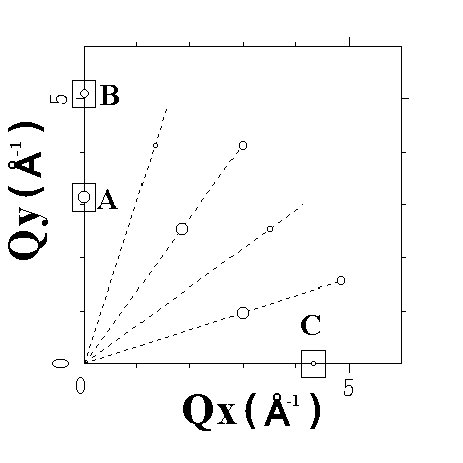 |
FIG.1
Reciprocal space perpendicular to the periodic direction of the decagonal
Al72Ni20Co8. The area
of the spot is proportional to the intensity of reflections. The diffuse
scattering has been measured around the labeled
reflections..
|
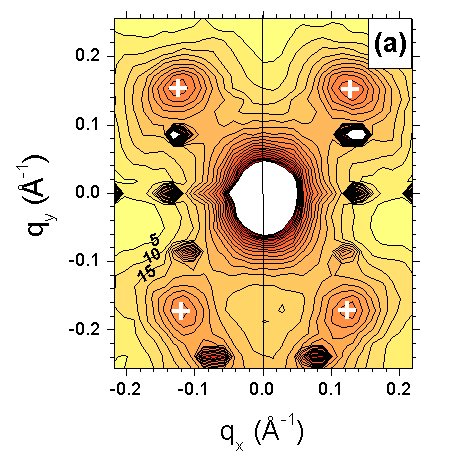 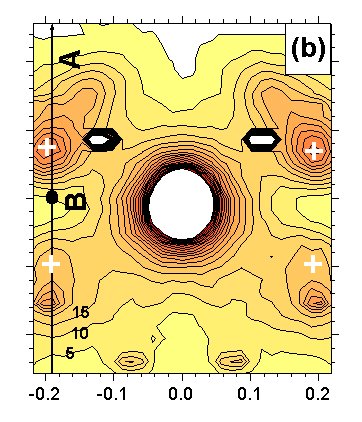 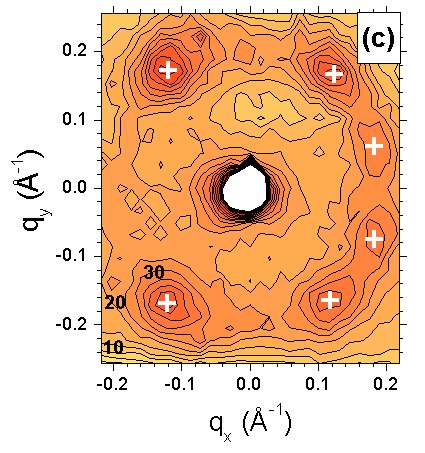 |
FIG.2
Diffuse scattering on the quasiperiodic plane (Qx, Qy)
around (a) 10-3-30 , (b) 30-4-40 and (c) 1-2-5-40 at 8.304
keV, where each interval of contour maps is 5 electron units per atom. The
raveled reflections of A, B and C in Fig.1 stand for 10-3-30,
30-4-40 and 1-2-5-40 . The white crosses on broad peaks exhibit the
positions of superstructure reflections. Other sharp peaks are main
reflections. Line A in Fig. 2(b) is a measurement region in Fig. 4(a). Dot
B in Fig. 2(b) is used for the calculated values in Table
I.
|
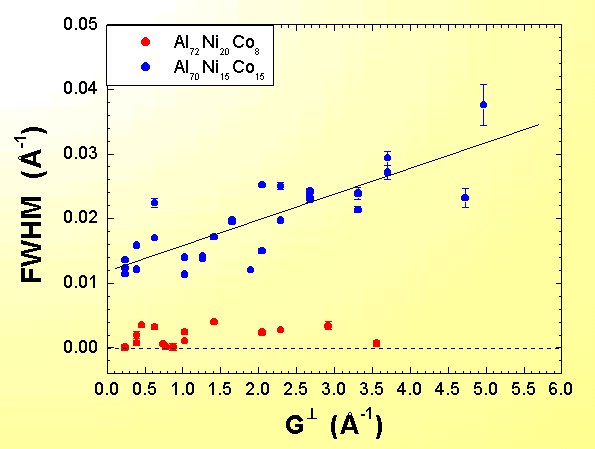 |
FIG.3
FWHM of Bragg reflections along | Gperp|. Open circles are
FWHM of Al70Ni15Co15 and closed circles
are that of Al72Ni20Co8. FWHM values are deconvoluted by the
experimental resolution function.
|
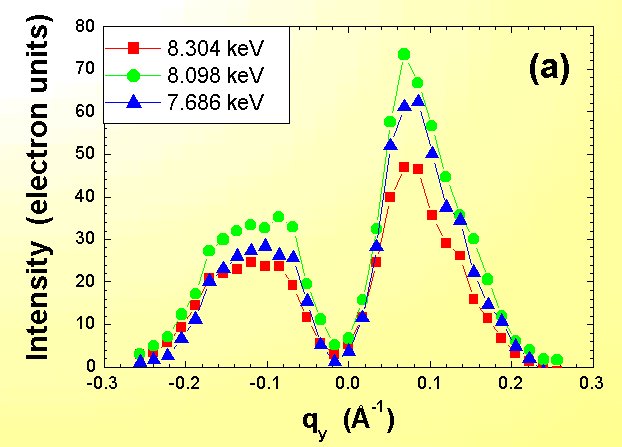 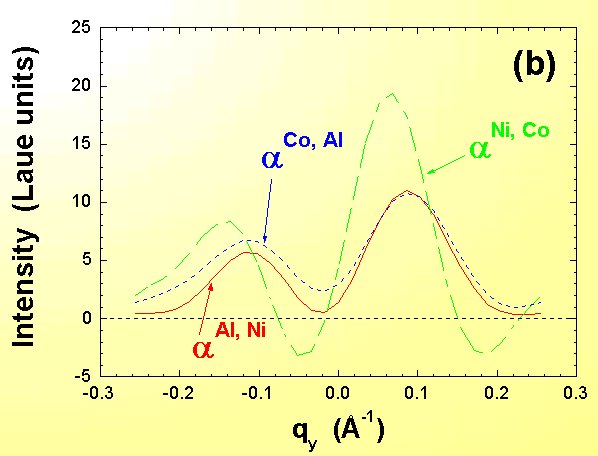 |
Fig. 4
(a) Line-scan along Qy in line A of Fig 2(b) around the
Bragg reflection. Open squares, open circles and closed triangles are diffuse
intensities at 8.304, 8.098 and 7.686 keV, respectively. (b) Three kinds
of pair-correlation functions, aAl,Ni(Q), aNi,Co(Q)
and aCo,Al(Q), in Laue units per atom at the same Q
region. |
References
1) S. Ritsch, C. Beeli, H. ?U. Nissen, T. Godecke, M. Scheffer and R. Luck:
Philos. Mag. Lett. 74 (1996) 99.
2) A. P. Tsai, A. Fujiwara, A. Inoue and T. Masumoto: Philos. Mag. Lett. 74 (1996) 233.
3) K. Saitoh, K. Tsuda, M. Tanaka, K. Kaneko and A. P. Tsai: Jpn. J. Appl. Phys. 36 (1997) L1404.
4) E. Abe, K. Saitoh, H. Takakura, A. P. Tsai, P. J. Steinhardt and H.
?C. Jeong: Phys. Rev. Lett. 84 (2000) 4609.
5) K. Hiraga, F. J. Lincoln and W. Sun: Mater. Trans. JIM 32 (1991) 308.
6) K. Edagawa, H. Sawa and S. Takeuchi: Philos. Mag. Lett. 69 (1994) 227.
7) K. Hradil, T. Proffen, F. Frey, S. Kek, H. G. Krane and T. Wroblewski:
Philos. Mag. B 71 (1995) 955.
8) A. Baumgarte, J. Schreuer, M. A. Estermann and W. Steurer: Philos. Mag. A 75 (1997) 1665.
9) M. de Boissieu, M. Boudard, B. Hennion, R. Bellissent, S. Kycia, A.
Goldman, C. Janot and M. Audier: Phys. Rev. Lett. 75 (1995) 89.
10) M. J. Capitan, Y. Calvayrac, A. Quivy, J. L. Joulaud, S. Lefebvre and
D. Gratias: Phys. Rev. B 60 (1999) 6398.
11) H. Abe, N. Tamura, D. Le Bollofh, S. C. Moss, Y. Matsuo, Y. Ishii and J. Bai: to be published in Mater. Sci. Eng. A (2000).
12) T. C. Lubensky, J. E. S. Socolar, P. J. Steinhardt, P. A. Bancel and
P. A. Heiney: Phys. Rev. Lett. 57 (1986) 1440.
13) Y. Ishii: Phys. Rev. B 45 (1992) 5228.
14) S. C. Moss: Mater. Res. Soc. Symp. Proc. 376 (1995) 675.
15) L. Reinhard, J. L. Robertson, S. C. Moss, G. E. Ice, P. Zschack and
C. J. Sparks: Phys. Rev. B 45 (1992) 2662.
16) S. Hashimoto, H. Iwasaki, K. Ohshima, J. Harada, M. Sakata and H. Terauchi: J. Phys. Soc. Jpn. 54 (1985) 3796.
17) M A. Chernikov, H. R. Ott, A. Bianchi, A. Migliori and T. W. Darling:
Phys. Rev. Lett. 80 (1998) 321.
18) M. Widom, to be published in Philos. Mag. A.
 Back
to Publications List
Back
to Publications List
ab@nda.ac.jp
Department of Materials Science and Engineering
National Defense Academy
Last Modified: Dec. 21, 2009






